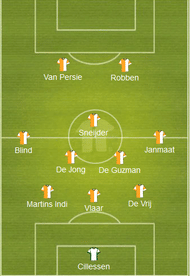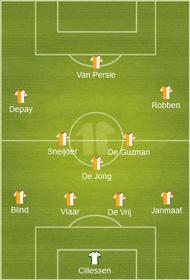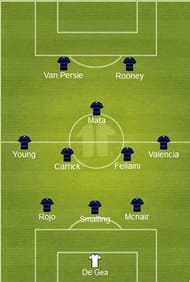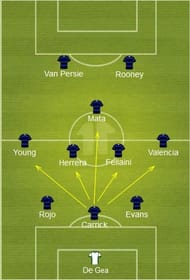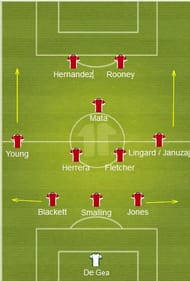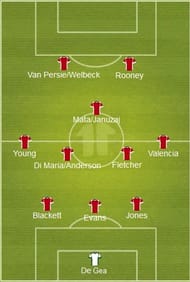After winning their last five matches, Manchester United have slowly but steadily started to gain momentum in the league. At Old Trafford, their form looks particularly impressive as United have won six of the last seven home games. Changing the back three to a flat back four has played a major role in the clubs recent success.
After Louis van Gaal’s Holland exceeded everyone’s expectation in Brazil 2014, the Dutch manager followed the same recipe by deploying a three-man defence in his early days at United. The changes initially worked, as United won all their five pre-season games. But, reality struck when United faced Swansea in the opening day of the season as the Reds lost 2-1 at Old Trafford.
Despite the early alarm bells, Van Gaal did not change the formation for the next three matches. In that period United drew two and were humiliated in the other by lower division club MK Dons in the Capital One Cup.
Van Gaal did not just play with 3 at the back at the World Cup
So many wondered why the formation which was successful for Dutch in the World Cup, failed to work properly for United. Various explanations can be made however, the real question is, did the formation really work for Holland in the World Cup?
When a team finished third in the World Cup, not many would question the team tactics or formations. But, truth to be told only in two of those victories, Van Gaal stuck with the same 3-5-2 formation till the 90 or 120 minutes. Both were undoubtedly remarkable victories against Spain and Brazil. However, in the remaining matches, the Dutchman had to tweak the formation in the second half to get the result.
After thrashing Spain in the opening match, Netherlands started with the same formation against Australia in the following match. With Australia enjoying more success in the first half, Van Gaal replaced the injured centre back Bruno Martins Indi with the young winger Memphis Depay. Thus the team switched from 3-5-2 to a traditional 4-3-3 to edge past Australia. Ron Vlaar and Stefan de Vrij occupied the centre back positions and they were supported by Daryl Jamnaat and Daley Blind on either side of a flat back four during the second half. Compared to the defensive approach in the first half, the changes helped the team in playing a quick passing style of football to gain initiative in the match.
The match against Mexico is another example. Van Gaal switched from 3-5-2 to a 3-4-3 in the second half by bringing on Depay. With no change in fortunes, the manager deployed a familiar 4-4-2 during the end. In the back, Vlaar and Di Vrij was supported by Janmaat (right back) and Blind (left back). Wijnaldum and Sneijder occupied the midfield positions. While Huntelaar (who replaced the ineffectual Van Persie) and Dirk Kuyt played up front, who were supported by wingers Robben and Depay. The change helped in the Dutch getting a last gasp 2-1 victory.
In the penalty shootout victory against Cost Rica, the Dutch finished the match with a 4-4-2 formation as the centreback Bruno Martins Indi was replaced by Huntelaar in extra time to support Robin van Persie up front.
The Netherlands were not expected to reach the semifinals of the World Cup according to many. They were termed as underdogs when they faced the giants of the game. So the conservative 3-5-2 set up helped them in keeping the defence tight. However, Manchester United will rarely go into a match as underdogs, so a conservative defensive approach with the Red Devils did not help Van Gaal.
Lack of adaptable centre-backs at United
After watching his side lose two and drawing the other two matches in August, Van Gaal finally switched to a flat back four. The very first test was a success as the Red Devils beat Queens Park Rangers 4-0. After that United went on to win five of the next six home matches.
The lack of centre halves who could adapt to the role (back three) did not help the team in fulfilling the required task. With a back three, the defenders have to cover more ground than usual and they also have to be more decisive with the passing. Since, an attacker is sacrificed for an extra defender, it is vital for the defenders to be more involved in the passing game.
The game against Southampton on Monday night is the best example. As United struggled to pass their way from the back in the first half, the Dutch manager replaced young Paddy Mcnair with Ander Herrera. Hence, the team was reshuffled. Carrick slotted in the centre of the back three, while Evans and Rojo occupied the right and left-sided centre half positions respectively. The change helped in United retaining the possession and starting the play from the back.
Former England and Arsenal centreback Tony Adams said, “If you play at the centre of the three, as I did, you do more running from side to side to cover your partners. Three across the defensive line instead of four creates more space to fill. As a big tall central defender, playing as one of the outside defenders is tricky.”
Using makeshift wing-backs did not bring ideal results
Moreover, the task of the wing backs is hectic when playing with just three defenders. While defending, they have to fall back and help the back-line and when attacking, the wing backs have to surge forward like wingers. This system cannot be implemented properly without possessing proper wing-backs.
Dirk Kuyt, is the kind of player United are missing from the Dutch squad. In Brazil 2014, he played in both the wing back positions and against Mexico, he ended up playing as a striker. Manchester United also have players like Antonio Valencia and Ashley Young to play in multiple positions. But, United do not have the right players to do the job, as both Valencia and Young prefer to attack rather than defend.
As shown in the above illustration, Manchester United started the defeat against Swansea in the opening day with three at the back. Notably, Anders Lingard and Young were the fullbacks. When Lingard got injured, Januzaj replaced him. Thus, both of United’s wing back positions were filled with makeshift wingers. Eventually, Jones and Blackett had to move into the flanks to make up for the space left by Young and Januzaj, which left them exposed in the middle.
Having said that United’s both away victories in the season have come when they played three at the back. In truth, the match against Arsenal could have been over by the half hour mark if not for David de Gea’s brilliance. And against Southampton, Louis van Gaal himself admitted that Manchester United were fortunate to beat the Saints. So the formation cannot be rewarded for United’s victory and moreover the changes were forced upon Van Gaal due to the team’s injury crisis.
Return of the back four
Clubs in England, especially Manchester United are always known for playing four at the back. Starting from the youth system, the club follows the same trend and the youngsters who are coming up the ranks are trained in the same way. Hence, switching to an unfamiliar formation made life difficult for the players.
Finally when Van Gaal switched to a flat back four, the defenders breathed a huge sigh of relief. As the defence was sorted, the players expressed themselves with more freedom up front.
In the game against Burnley, as the players were unsure about their position, United played it safe and ended with a dull goalless draw. Moreover, Van Gaal had to fit the players in unusual positions to make the tactics work for the team. Angel Di Maria played as a deep-lying midfielder. While Juan Mata’s replacement Januzaj was also forced to fill the Spaniard’s position rather than his usual wide role. Hence, the players were not able to give their best in that setup.
Once the players were put back to their normal positions, free flowing football returned to Old Trafford. Also the team’s organisation improved as the understanding between the players developed.
It may be too early to rule out the possibility of playing a back three, however with Manchester United winning six, drawing two and losing only two of the 10 matches played with a back four this season, it is safe to assume that United are more comfortable with a back four rather than the unusual back three.
